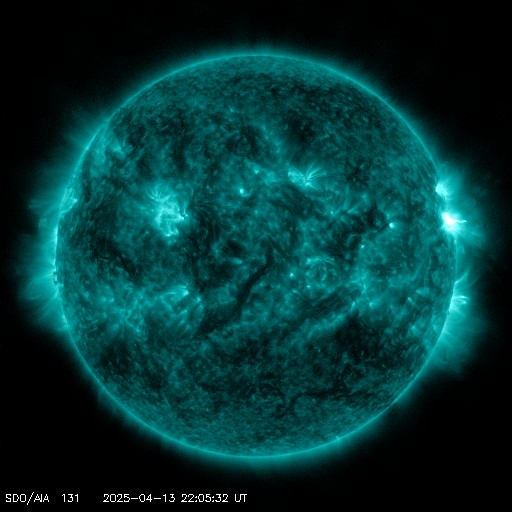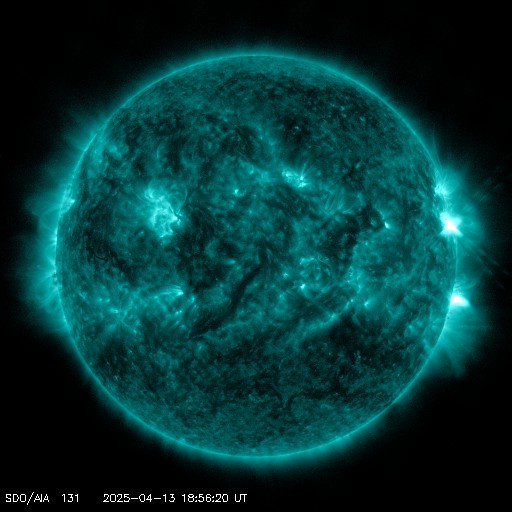Viewing archive of Thursday, 11 June 2015
Daily bulletin on solar and geomagnetic activity from the SIDC
Issued: 2015 Jun 11 1230 UTC
SIDC Forecast
Solar flares
M-class flares expected (probability >=50%)
Geomagnetism
Minor storm expected (A>=30 or K=5)
Solar protons
Quiet
| 10cm flux | Ap | |
|---|---|---|
| 11 Jun 2015 | 150 | 011 |
| 12 Jun 2015 | 160 | 020 |
| 13 Jun 2015 | 165 | 007 |
Bulletin
Solar activity has increased since the last bulletin. More than a dozen C-class flares and one M1.0 flare were observed by the GOES spacecraft. Almost every currently visible sunspot group contributed to this activity. The M1.0 flare, peaking at 8:55 UT on June 11 originated from a region that is currently turning to the Earth-facing side of the Sun. More flaring activity is to be expected, certainly at the C-level. Also an additional M-class flare is possible, mainly from the new region at the East limb (no NOAA number yet). The latest coronagraphic images indicate the occurrence of a CME propagating east of the Sun-Earth line, but more complete data are needed to analyse this.
The effects of the high speed stream are gradually decreasing. The solar wind speed is currently around 570 km/s and the interplanetary magnetic field magnitude obtains values below 5 nT. Geomagnetic conditions remain quiet to unsettled (K= 1 to 3), which is expected to continue for the next few hours. Geomagnetic activity might reach active to at most minor storm levels on June 12, depending on the potential arrival of the June 9 CME and the magnetic field properties.
Today's estimated international sunspot number (ISN): 074, based on 14 stations.Solar indices for 10 Jun 2015
| Wolf number Catania | 136 |
| 10cm solar flux | /// |
| AK Chambon La Forêt | 017 |
| AK Wingst | 014 |
| Estimated Ap | 013 |
| Estimated international sunspot number | 074 - Based on 27 stations |
Noticeable events summary
| Day | Begin | Max | End | Loc | Strength | OP | 10cm | Catania/NOAA | Radio burst types |
|---|---|---|---|---|---|---|---|---|---|
| 11 | 0849 | 0855 | 0859 | ---- | M1.0 | --/---- |
Provided by the Solar Influences Data analysis Center© - SIDC - Processed by SpaceWeatherLive
All times in UTC
Current data suggests there is a slight possibility for aurora to appear at the following high latitude regions in the near future
Gillam, MB, Iqaluit, NUNuuk
Reykjavik
Latest news
Latest forum messages
Support SpaceWeatherLive.com!
A lot of people come to SpaceWeatherLive to follow the Sun's activity or if there is aurora to be seen, but with more traffic comes higher server costs. Consider a donation if you enjoy SpaceWeatherLive so we can keep the website online!

Latest alerts
Sunday, 13 April 2025
22:21 UTC - Solar flare
Moderate M1.66 flare from sunspot region 4055
22:03 UTC - Radio Blackout
Minor R1 radio blackout in progress (≥M1 - current: M1.01)
20:48 UTC - Hemispheric Power Index
The OVATION model predicts the Hemispheric Power Index to reach 50GW at 21:39 UTC
19:09 UTC - Solar flare
Moderate M3.24 flare from sunspot region 4055
18:51 UTC - Radio Blackout
Minor R1 radio blackout in progress (≥M1 - current: M1.07)
Space weather facts
| Last X-flare | 2025/03/28 | X1.1 |
| Last M-flare | 2025/04/13 | M1.6 |
| Last geomagnetic storm | 2025/04/06 | Kp5 (G1) |
| Spotless days | |
|---|---|
| Last spotless day | 2022/06/08 |
| Monthly mean Sunspot Number | |
|---|---|
| March 2025 | 134.2 -20.4 |
| April 2025 | 136.4 +2.2 |
| Last 30 days | 134.2 -8.9 |




